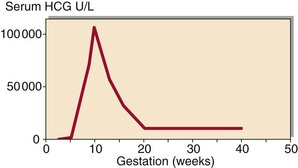75 Human chorionic gonadotrophin (HCG) is a glycoprotein produced by the chorionic cells of the developing embryo that is detectable by sensitive assays within days of conception. Measurement of HCG is used to confirm pregnancy, and forms the basis of pregnancy tests (p. 9). The protein’s rapid rate of synthesis in early pregnancy provides systemic evidence of the blastocyst 24 hours after implantation. HCG continues to be secreted by the developing placenta, and serum and urine concentrations increase during the first 9 weeks of pregnancy, then decline gradually until the third trimester (Fig 75.1). The function of HCG is to maintain the activity of the corpus luteum sustaining progesterone synthesis. Measurement of HCG is also of value in: Prenatal diagnostic techniques fall into two groups: invasive and non-invasive (Table 75.1). Prenatal diagnosis may be required because of increased risk of inherited disease. Neural tube defects cannot usually be predicted by family history, and pregnant women may be offered a screening test to detect these disorders. For further details on antenatal screening see pp. 154–155. Table 75.1 Techniques for prenatal diagnosis
Fetal monitoring and prenatal diagnosis
HCG
 Assessing fetal viability in threatened abortion.
Assessing fetal viability in threatened abortion.
 Detecting ectopic pregnancy. HCG fails to rise at the expected rate. In the first trimester of a normal pregnancy it approximately doubles every 48 hours.
Detecting ectopic pregnancy. HCG fails to rise at the expected rate. In the first trimester of a normal pregnancy it approximately doubles every 48 hours.
 Detecting and monitoring hydatidiform mole and choriocarcinoma. HCG may be used as a tumour marker for diagnosis and monitoring of these trophoblastic malignancies (pp. 140–141).
Detecting and monitoring hydatidiform mole and choriocarcinoma. HCG may be used as a tumour marker for diagnosis and monitoring of these trophoblastic malignancies (pp. 140–141).
Prenatal diagnosis
Invasive
Amniocentesis
Chorionic villus sampling
Cordocentesis
Fetoscopy ![]()
Stay updated, free articles. Join our Telegram channel

Full access? Get Clinical Tree

 Get Clinical Tree app for offline access
Get Clinical Tree app for offline access

